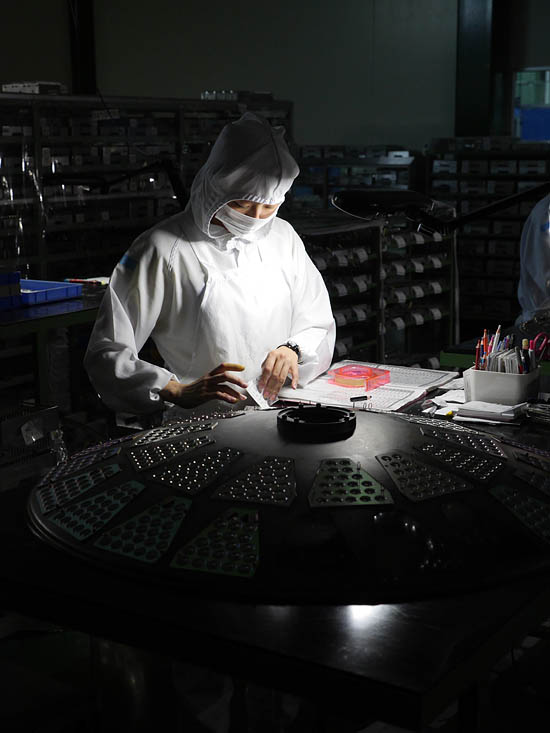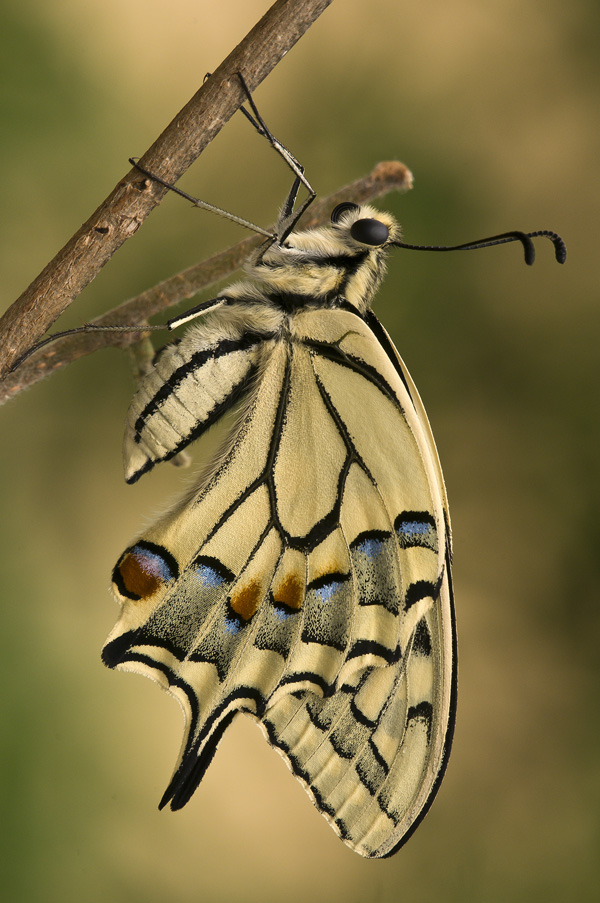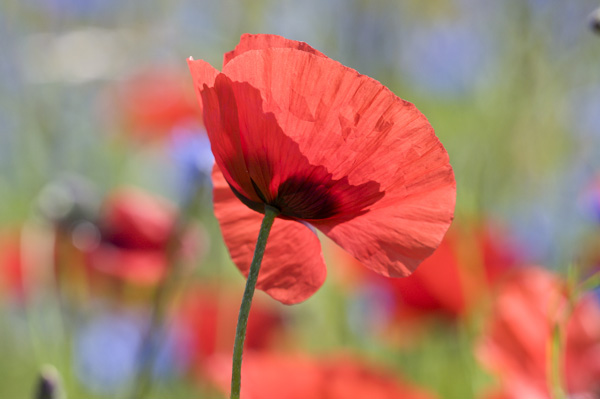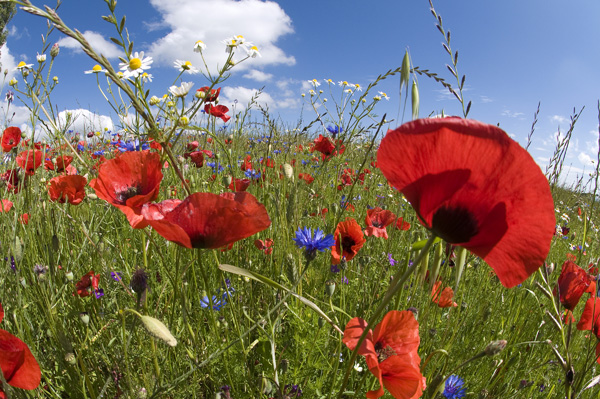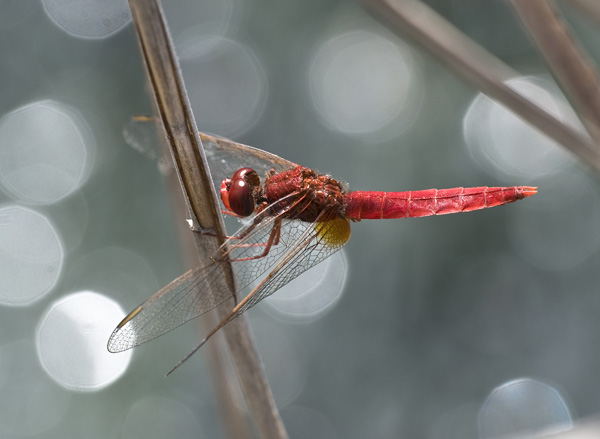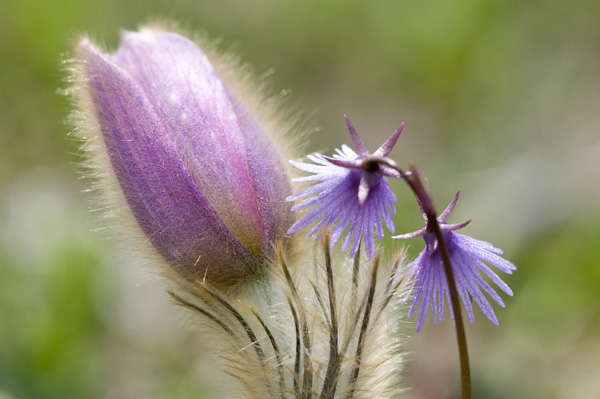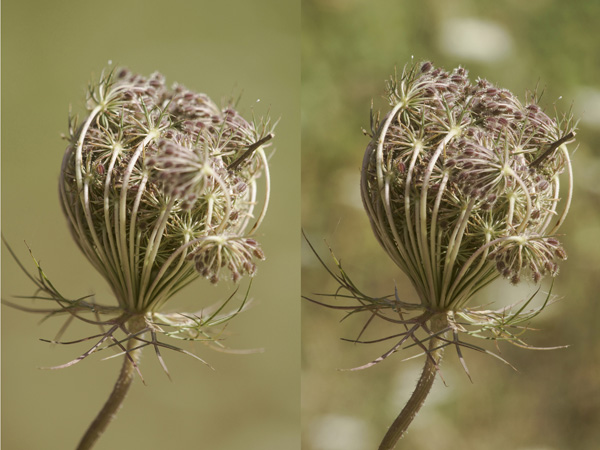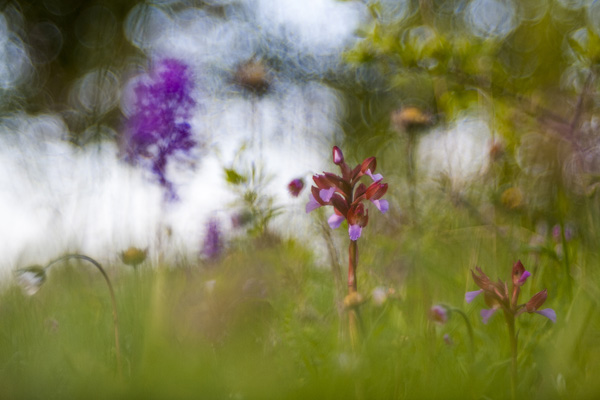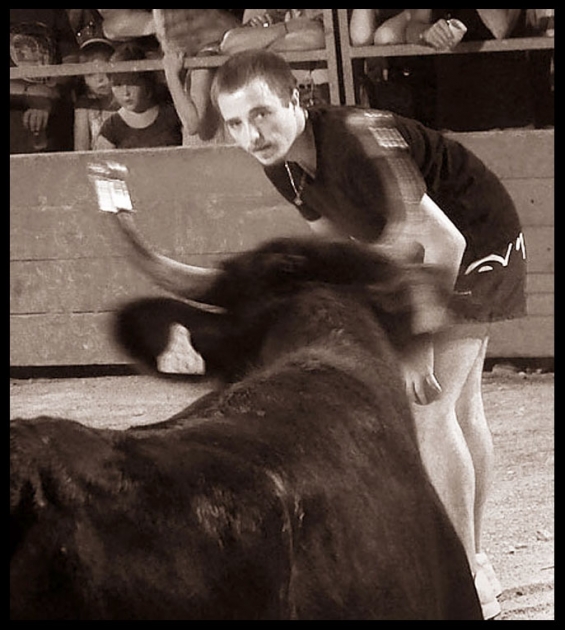=================================================================
To subscribe, unsubscribe or change your email address, visit:
http://www.imaging-resource.com/IRNEWS/index-subs.html
Support the Newsletter!
- Find the best price for anything at http://ir.pricegrabber.com
- Shop Amazon, Adorama at http://www.imaging-resource.com/buynow.htm
=====================================================
THE IMAGING RESOURCE DIGITAL PHOTOGRAPHY NEWSLETTER
=====================================================
Volume 15, Number 20 - 20 September 2013
----------------------------------------------------------------------
Copyright 2013, The Imaging Resource. All rights reserved.
----------------------------------------------------------------------
Welcome to the 368th edition of The Imaging Resource Newsletter. In this issue, publisher Dave Etchells takes us on a fascinating, in-depth tour of Sigma's lens factory in Aizu, Japan. (Note: You'll have to click through to the IR site to read the full article, since it's a lengthy piece filled with photos of the facility and manufacturing processes. Trust us, you'll want to check this out!) We also share a shooter's report excerpt from our final review on the groundbreaking Canon 70D DSLR. And pro photographer and nature wide-angle macro expert Paul Harcourt Davies helps us better understand the art and science of bokeh. Finally, we serve up our usual roundup of quick hit topics, answers to reader mail, and links to some of the best stories we published on the IR site in the past two weeks. Happy reading!
TOPICS
----------
Get Social with IR
Sponsors
Special Online Report: A Photo Geek's Tour of Sigma's Aizu Lens Factory
Camera Review: Canon 70D Shooter's Report Excerpt
Feature: Understanding Bokeh: The Art and Science Behind the Beauty of Blur (Part 1)
Quick Hits: Initial Olympus E-M1 review, Steve Meltzer splits from the herd, Sony NEX-3N review
We've Got Mail
New on the Site
Next Issue
Signoff
GET SOCIAL WITH IR
---------------------------
If you want to stay up-to-date with the latest camera and photography news, get notified when IR posts its latest camera or lens review, and much more, please get social with us on your favorite networking sites by:
By doing so, you'll also be supporting our efforts to deliver the best camera and photography content on the planet. (Google in particular apparently pays lots of attention to Google+ in deciding site/page relevance for its search results, so "circling" us there and +1-ing our site and pages would be an especially big help.) Thanks! We appreciate it!
SPONSORS
--------------
This issue is sponsored in part by the following companies. Please show your appreciation by visiting the links below. (Visiting our sponsor's links really helps support this newsletter, thank you for your attention!) And now a word from our sponsors:

* Sigma *
Sigma's new Global Vision lenses feature the latest technology
and combine optical performance resulting in a tour de force
that meets all of your photographic needs.
Our new lenses include the new
35mm F1.4 DG HSM 'Art',
17-70mm F2.8-4 DC Macro OS HSM 'Contemporary' and
120-300mm F2.8 DG OS HSM 'Sport'.
Our cameras, featuring the Foveon X3 sensor, include the SD1 and the
DP Merrill, produce the highest quality digital images.
Learn more about Sigma offerings at http://www.imaging-resource.com/cgi-bin/nl/pl.cgi?sg13
-----------------------------------------------------------------------------------------------------
Are you in the digital photo business? This newsletter is read by more than 47,000 direct subscribers (plus additional pass-along readers), all with a passion for digital photography. For information on how you can reach them, contact us at editor@imaging-resource.com.
-----------------------------------------------------------------------------------------------------
SPECIAL ONLINE REPORT: A Photo Geek's Tour of Sigma's Aizu Lens Factory
----------------------------------
by Dave Etchells
On a trip to Japan this past August, Sigma Corporation's CEO Kazuto Yamaki asked if I'd like to tour the company's factory in Aizu Wakamatsu. Engineer/geek that I am, I couldn't possibly resist.
Sigma Corporation has been a leading player in the third-party lens business since there was a third-party lens business. Long seen primarily as a source of inexpensive add-on lenses, they've recently been reshaping themselves into a purveyor of true high-end, no-excuses glass that's in the top tier of optical performance. (In our recent SLRgear review, we called the new Sigma 18-35 mm f/1.8 DC HSM "A" "by a wide margin, the best constant-aperture/wide-aperture zoom lens we've ever tested.") With this as background, the opportunity to have a true, no-holds-barred geek's tour of their factory was a chance not to be missed.
So it was that I found myself on a short flight from Osaka to the Fukushima airport, where I was met by Shinji Yamaki, Sigma's manager of European marketing. A pleasant 90-minute car ride through the mountainous countryside brought us to the Sigma factory in Aizu. The Aizu site has been home to Sigma's manufacturing from very early on, only a few years after Kazuto-san's father founded the company. Aizu is an interesting region historically, with a somewhat sad tale of betrayed loyalty to the Emperor during the Civil War period, which led to a long period of relative isolation from the rest of Japan. In some part, that isolation and the culture it produced is what led to Sigma locating their factory there.
In the early days of Sigma, Michiharo Yamaki (Kazuto-san's father, and founder of the company) faced stiff competition for skilled workers in the Tokyo area, as it was then the boom time of the Japanese optical industry, with not enough skilled workers to go around. Through a worker from the Aizu region, Michiharo-san learned of the local population's reputation for diligence and ability to concentrate on fine details. A recruiting trip to the area led to a particular night that involved a great deal of sake, in which the local farmers pressed Mr. Yamaki to build a factory in the area. They were hoping for jobs that they could work at in between their agricultural duties. In a moment of inebriated agreeableness, Michiharo-san half-jokingly said "sure, I'll build you a factory." The next morning, he discovered to his dismay that, while he had been joking, the farmers were completely serious. After a not-insignificant amount of badgering, Mr. Yamaki r
elented, rented a single room in someone's home, stuck a metal lathe in it and hired a person to run it. That was the beginning of Sigma's manufacturing in Aizu.
Read the full story online here: http://www.imaging-resource.com/news/2013/09/19/a-geeks-tour-of-sigmas-aizu-lens-factory-precision-production-from-the-insi
-----------------------------------------------------------------------------------------------------
REVIEW: Canon EOS 70D Shooter's Report (Excerpt)
-----------
(Check out our final, in-depth Canon 70D review, complete with videos that show off its revolutionary AF system, gallery photos, comparison crops, lab test results and our ultimate conclusion: http://www.imaging-resource.com/PRODS/canon-70d/canon-70dA.HTM)
by William Brawley
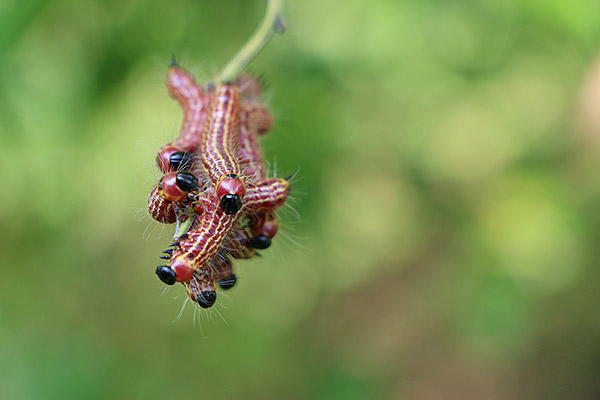 |
The Canon 70D coupled with the 18-135mm f/3.5-5.6 IS STM lens proved to be a great, comfortable combo that produced sharp images, pleasing colors and nice, creamy bokeh. (Shot with Live View) |
When Canon announced the 5D Mark II five years ago, it took the video production world by storm. It was the first full-frame DSLR with high-definition video recording capabilities, and was offered at an extremely affordable price compared to other large-sensor video cameras at the time. It wasn't a slim margin, either: The Canon 5D II was tens of thousands of dollars more affordable, and yet still had a larger sensor than its rivals!. However, for the average video shooter or casual consumer, the 5D Mark II and other subsequent HD-DSLRs all lacked a critical feature: full-time continuous autofocus for video.
Now, the Canon 70D isn't the first Canon DSLR with video autofocus by any means, as most of the brand's newer models have some form of continuous Live View AF. However, the Canon 70D feels like the first DSLR that does continuous Live View AF properly. Canon's new Dual Pixel CMOS AF is pretty amazing -- and not just for video. It works great for still photography, too, as I found out during my time putting it through its paces.
I've been a Canon user for a few years now and shoot both still photography and video. I started with a 7D, and a while later added a 5D Mark II to the mix. In terms of still photography, I love my 5D Mark II for landscapes and occasional events or portraits, but my 7D has been my go-to still camera for capturing anything fast and tough to shoot, such as sports and wildlife, thanks to its more advanced autofocus and higher speed continuous shooting.
When I first learned about the 70D's new AF system, it was immediately clear the camera would be huge for the video crowd, but I wondered how it would handle still photography. My personal preference when shooting stills with a DSLR is to use the viewfinder nearly 100% of the time, unless I'm on a tripod shooting landscapes or using manual focus. The 70D does have a dedicated phase-detect AF sensor for viewfinder shooting, just like any other DSLR. However, I started thinking creatively about what kinds of subjects I could shoot -- or shoot more easily -- in Live View mode, thanks to its Dual Pixel CMOS AF technology. Did it work? Oh yes! But I won't spoil the surprise just yet. Let's take a closer look at the camera, first.
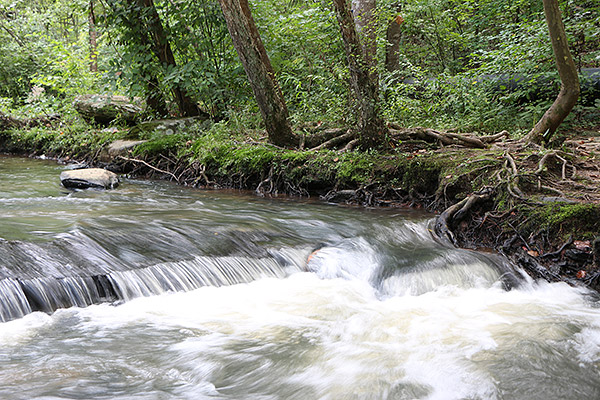 |
Out for a hike? The 70D is light enough to carry in your hand, over the shoulder or in a backpack for a day outdoors. (Shot with Live View) |
Design and feel. The Canon 70D takes its design cues from the 7D and morphs them with the 60D. I like the result. Having used a 7D extensively, the 70D feels very similar in-hand with a comfortable, contoured, heavily rubberized grip and subtle indentations for your fingers. The 70D is a bit smaller than the 7D -- and the 60D too, but only by a hair -- yet still has a nice heft to it, and my hand fits nicely around it.
The 60D's body was comprised of an aluminum chassis with an exterior of polycarbonate resin and fiberglass, and it appears that the 70D has retained that design and construction choice. The 70D is heavier than the 60D by nearly 3 ounces (80g), but since I'm used to carrying heavier cameras, I found the 70D was still comfortable to hold. It didn't weigh me down at all when I carried it around in my bag.
The 70D maintains the characteristic articulating LCD screen design of the 60D. In the past, I've normally dismissed this type of screen as somewhat gimmicky, and something that either adds bulk or is more fragile and easily broken. However, after using the 70D, I have to say, I think I'm a convert. For certain scenarios, I discovered that I love the 3-inch tilt-screen, such as when I needed to shoot at awkward angles on a tripod. The LCD folds out from the body and can swivel 270 degrees. It can also be stored with the screen against the camera, meaning it's protected from scratches and bumps when I'm carrying it around, or when it's stashed away.
Coupled with fantastic capacitive touch capabilities, the articulating monitor proved to be a very versatile feature -- made even more important since Live View shooting has been improved by the 70D's Dual Pixel CMOS AF system. The touchscreen on the 70D is excellent, and feels very similar to that of a high-end smartphone. It doesn't appear to add any bulk compared to my 7D, and seems relatively robust and rugged. Quick, light touches are enough to navigate through menus or tap on icons, even on the "Standard" sensitivity setting. It's great for shooting video with the tap-to-focus feature, as I can minimize the risk of jostling the camera when tapping or pressing on the screen. In bright sunlight, the LCD is still very readable. There's some glare if the angle is just right, but thanks to the articulated hinge of the LCD, I could easily tilt it to eliminate glare.
Controls. Moving on to the buttons and control layout, the 70D looks unsurprisingly similar to the 60D for the most part. There are a few minor changes that, in my opinion, make it a little easier to use and more familiar to users of other Canon DSLRs. The first thing I noticed was the addition of the 7D's fantastic Live View toggle switch. Unlike the 60D, you don't have to rotate the Mode dial to Movie Mode, then tap the Live View button to start and stop video recording. Users of the 7D or 5D Mark III will be at home with the 70D in this regard.
One of my favorite controls on my 7D is the Multi-Function button, a small programmable button near the top scroll wheel behind the shutter release button. Canon has added a similar -- albeit single-function -- variant of this button to the 70D, and I love it. By default, the 7D set this button to toggle through the various AF point modes, and the 70D's button does the same. When doing traditional viewfinder shooting, pressing this button lets you quickly change AF modes (single-point AF, zone AF and 19-point automatic selection AF), and displays your options in the viewfinder.
The third change to the layout is that the Menu button is now in the upper left-hand corner, as it is on most of Canon's current DSLRs. This is great for those of us with a deeply ingrained motor memory of button layouts. Canon has also moved the Playback button right above the rear scroll wheel, making it much closer to the delete button. Users of the 60D should be happy that these two buttons are no longer in diagonally opposite corners of the camera. My brother owns a 60D, and he and I would both fumble with its button layout, which just didn't seem to make sense.
Lastly, the 70D maintains Canon's locking Mode dial that's become a mainstay in its other recent DSLRs, and which I've quickly grown to appreciate -- no more erroneous mode changes! The 70D also does away with cramming in a little icon for each Scene mode on this dial, as it did with the 60D. Now, there's simply a single "SCN" mode option on the Mode dial, and you can access and navigate through the various scenes on the touchscreen LCD.
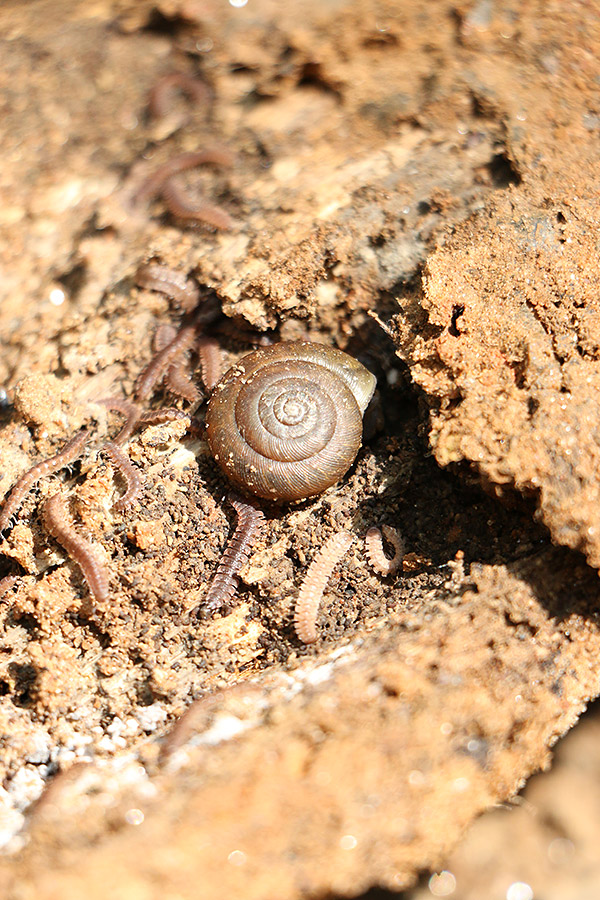 |
The 18-135mm kit lens provides decent "macro-ish" shooting capabilities with a 39cm (16 inch) minimum focusing distance and a magnification of 0.28x. (Shot with Live View) |
There are a couple of qualms I have with the controls on the 70D, albeit minor ones. The rear control dial on the 70D (and 60D) surrounds a multi-directional tilt-button unlike Canon's higher-end DSLRs which have a separate multi-directional joystick-like button placed above the rear wheel. I find that the larger-sized rear control dial of cameras like the 7D and 5D Mark II are easier to rotate without looking, and there's less risk of an accidental button-press on the multi-directional button.
I also miss a dedicated white balance button in the row of control buttons along the top LCD screen. The 70D actually has a set of five buttons, whereas the 7D, for example, has only four. Each button on the 7D has a dual function, one being adjusted by the top scroll dial and the other by the rear dial. The buttons on the 70D are all single function, however, and are adjusted by either control dial. With less room for options on the single-purpose buttons, Canon removed the quick white balance adjustment, which I found quite handy.
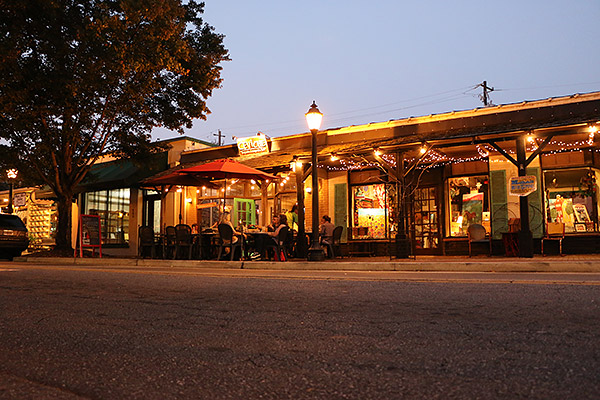 |
The Canon 70D's 3-inch articulated LCD screen, which can be pivoted 270 degrees, makes it easy to get uniquely-angled shots like this low-to-the-ground picture. |
Shooting with the 70D. If you've ever shot with any other prosumer-level Canon DSLR then you'll feel right at home operating the 70D. Control conventions and the menu system are standard Canon fare, but even users switching over from other brands should find this camera equally easy to use. Suffice to say, for me, switching over from my 7D and 5D Mark III to the Canon 70D was comfortable, familiar and easy.
My plan of attack for shooting with the 70D was to use Live View for the majority of my testing since it's this camera's claim to fame. However, traditional viewfinder shooting shouldn't be forgotten -- it's been substantially upgraded from the 60D as well. The 70D borrows the excellent 19-point all-cross-type AF system from the 7D. Shooters of fast action and wildlife will rejoice in this fact.
When shooting with the viewfinder, the phase-detect AF felt just as snappy as my 7D, or my 5D Mark II with the center AF point. Nothing stood out to me to indicate any lag or AF performance issues with phase-detect AF. Obviously, lens choice can affect the performance of autofocus, but when using a Canon USM or STM lens, the 70D focused very quickly. Our lab results found pro-grade AF shutter lag, and in real-world shooting, the 70D was certainly no slouch. Given that the 70D features the same 19-point all cross-type AF system from the 7D, it's not surprising that I found the 70D to be a excellent performer at AF speed and accuracy.
It's also worth noting that the 70D can shoot up to 6.7 frames per second in burst mode according to our lab testing, whereas the 7D goes up to 8fps. The 70D is not as fast, nor does it quite reach Canon's performance claim, but it's not too shabby either. It's much improved over the 5.3 frames per second speed we saw from the 60D.
Just how fast is the Canon 70D? Find out by clicking here to see our full battery
of rigorous, objective speed and operation tests conducted in the IR Lab.
Remember when I mentioned that the new Dual Pixel CMOS AF is great for still photography, and not just an advantage for video? As long as you're using a compatible lens, the Live View focusing actually feels almost as fast as traditional phase-detect autofocus through the viewfinder. I took the 70D out for a hiking trip with the new EF-S 18-135mm f/3.5-5.6 IS STM kit lens, and in bright sunlight, Live View AF blazed new trails for me photographically. When I first enabled Live View, I was pretty astonished with what happened when I gave the shutter button a half-press. I got tell-tale AF confirmation beeps almost instantaneously, which is pretty amazing compared to how other DSLRs perform in Live View. I'm used to resigning myself to expect slower AF results every time I enter Live View using my Canon DSLRs and EOS M, which all feature slower contrast-detect AF systems. Not so with the speedy 70D.
That said, where I feel the 70D really shines is not in normal, everyday still photography, where most users (including me) would simply use the viewfinder, but rather for certain shooting scenarios and tricky shots. After all, the 70D has a trifecta of features -- Dual Pixel CMOS AF, the articulating screen and Wi-Fi -- that make Live View shooting particularly awesome and present unique opportunities which other cameras just can't take advantage of.
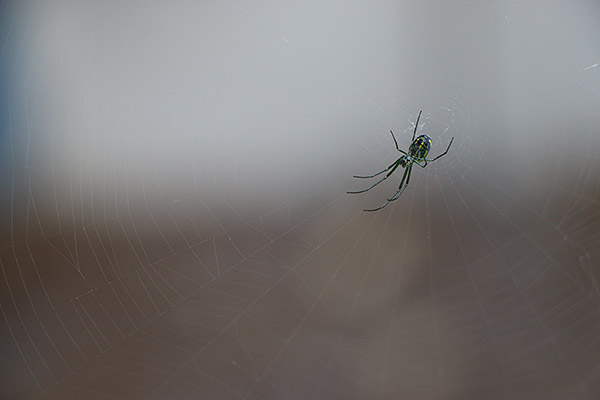 |
This was one of the worst-case-scenarios for the Dual Pixel CMOS AF in Live View mode. On subjects that are very tiny, like this little spider, the camera had a very difficult time focusing. The 70D immediately focused "through" the spiderweb. But most DSLRs would have this problem, too. |
Dual Pixel CMOS Live View AF + Wi-Fi + articulating LCD = fun. One of my favorite things to photograph is birds, and hummingbirds in particular. Hummingbirds are a tricky subject to shoot, since they are not only very tiny and extremely fast-moving, but they are also quite skittish around people -- or at least the ones I've encountered are. I've attempted to photograph them with a long telephoto lens, and many times even the slightest movement to raise my camera scares them away. Wouldn't it be nice to remotely set up a camera, yet still have the ability to see through the lens and have powerful subject-tracking autofocus? Enter the 70D.
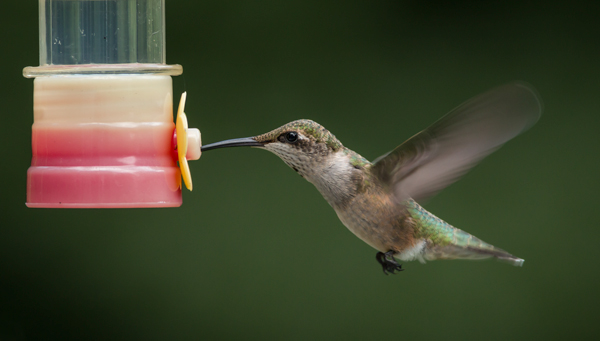 |
The Dual Pixel CMOS AF with AF Tracking did a great job locking on to fast moving subjects like this hummingbird. (Shot with a beta sample of the 70D AND a 400mm lens; Photo has been converted from raw and edited with Adobe Lightroom 5 & Photoshop CC.) |
I spent my first weekend with our earlier pre-production version of the 70D taking photos of hummingbirds with my 400mm f/5.6 L lens. Thanks to the 70D, I was able to get more shots of these little guys than I would have with my regular Canon cameras, trying to stand as still as possible. First, I placed the camera on a sturdy tripod, and due to the abysmal minimum focusing distance of the 400mm lens (~12 feet without using extension tubes), I had to position the camera practically up against the back of my house to get the framing I wanted. However, thanks to the articulating touchscreen, I could stand to the side of the camera and frame shots and configure settings in the menu with ease.
Next, I set up the Wi-Fi feature in the 70D. You are given the option of either connecting your smartphone or tablet to the camera via an existing Wi-Fi network, or turning the camera into a wireless access point and connecting your smart device directly to the camera. This is excellent if you're out in the field somewhere without any network connection.
I went with the direct-connect method and quickly connected my iPhone to the camera's network. Then I used Canon's EOS Remote app (available for Android and iOS), chose the remote shooting option, and after a few seconds, the Live View screen of the 70D appeared on my phone. Now I was ready to shoot.
On a side note, this was my first time using a Canon Wi-Fi-enabled camera with their EOS Remote app, and I have to say that I am thoroughly impressed. Not only can you simply trigger the shutter button and see the Live View screen, you can also fully adjust exposure settings like shutter speed, ISO and aperture all without touching the camera.
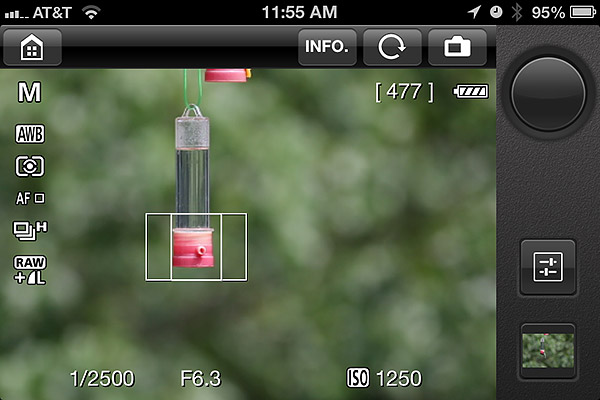 |
An example of what I saw using the Canon EOS Remote app on my iPhone 4s. The app -- which is also available for Android phones -- gives you not only remote shutter release, but also Live View, exposure control and image playback. |
Now, in terms of shooting and focusing, of course I could have simply pre-focused the lens and fired away when I saw hummingbirds fly in to view. However, I wanted to see how well the 70D's new focusing system performed, particularly with subject tracking. I set the 70D to Live View and to Face + Subject tracking AF mode, and framed the scene in a way that the bird would generally be in the focusing zone, which covers 64% of the sensor area.
This was my first time shooting a setup like this, and it was quite a humorous experience. In a way, I felt almost like I was cheating. Instead of standing out in the hot sun and humid air, I set up the camera, high-tailed it inside and captured some great wildlife shots all from the air-conditioned comfort of my living room.
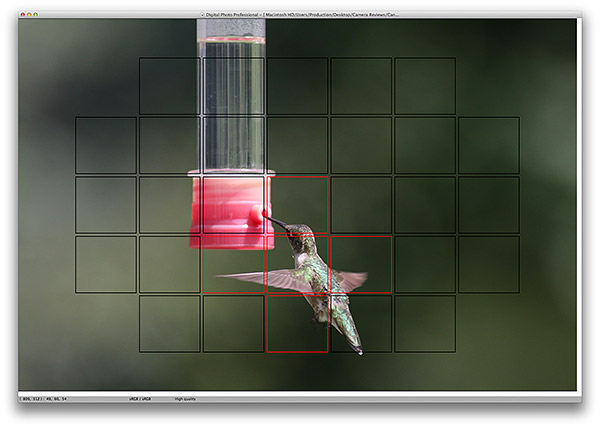 |
When the hummingbirds slowed down just a bit, the 70D's Dual Pixel AF tracking was able to find the subject and lock on very quickly. This screenshot comes from Canon's Digital Photo Professional software, which has the ability to display the AF point(s) used by the camera. |
The results? I was very impressed that the 70D did everything I wanted it to. The AF tracking did a good job of recognizing the hummingbird as it flew into the frame, and although there was a very slight delay until it appeared on the Live View display inside the smartphone app, I was able to trigger the shutter in high-speed continuous mode and snap some photos. More often than I expected, the AF tracking locked on to the hummingbird as it flew into the frame.
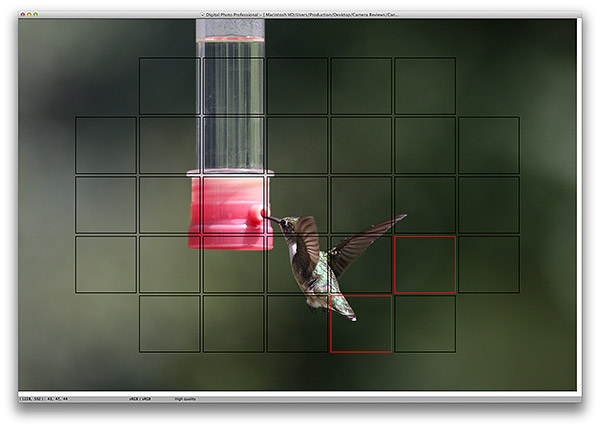 |
Of course, shooting like this, the Dual Pixel AF wasn't always perfect. According to the EXIF on this photo, it was taken just 5 seconds earlier than the shot shown above. The bird zoomed into the frame quickly, and for the first sequence of shots, the AF was just slightly off, but the 70D quickly adjusted, as shown in the previous screenshot. |
Now, no autofocus system is perfect and of course it missed the mark times, either by remaining locked onto the bird feeder or sometimes just deciding to focus on something else in the frame for whatever reason. Sometimes, it would catch the bird just a fraction too late. This is to be expected whenever you're relying on the camera to calculate and select its own AF point. Also, I was most likely pushing the Dual Pixel CMOS AF system to the extreme, as Canon specifically told us that for small objects in the frame like birds in flight, that traditional phase-detect autofocus is much more reliable and recommended. However, the fact that I can get nearly as fast AF speed in Live View as I can with regular phase-detect AF was very impressive.
The 70D's Dual Pixel CMOS AF system also did a great job in low-light situations and at night. For the most part the 70D had few problems focusing in dark areas; it was only when trying to focus on low-contrast or very dark objects that the Dual Pixel system had issues locking-on.
 |
The Canon 70D was able to handle low-light scenes very nicely, producing slightly less high-ISO noise than did the 60D or 7D. |
The kit lens (well, one of them). When I took the 70D out for a hike and some nature shooting, I took along with me one of the two kit lenses that Canon offers with the 70D -- the EF-S 18-135mm f/3.5-5.6 IS STM. This pairing was quite light and easy to carry around in my hand or backpack. The lens itself is fairly lightweight, yet there's still a little heft to it that adds a feel of quality and durability. It's quite unlike the more plasticky feel of the EF-S 18-55mm f/3.5-5.6 IS STM lens, which is the other kit lens option with the 70D. The 18-135mm lens also features a metal lens mount as opposed to the 18-55mm's plastic one. (Though the 18-55mm's build isn't quite as nice, it's still better-than-average for a kit lens and a good value.)
Want to learn more about the Canon 70D's EF-S 18-135mm f/3.5-5.6 IS STM kit lens?
Click here to see our optical test results.
The key features of the 18-135mm lens are its versatility, long zoom range and image stabilization. I really enjoyed having the reach of 135mm; I hadn't used a lens like this one in a long time. (I owned the Nikon 18-135mm lens with my D80 many years ago.) At 18mm, the lens provides a decently-wide angle of view, if not as wide as I would have liked. (I'm a fan of ultra-wide angle lenses.) I ended up using the longer end of the lens more, though. The 18-135mm has a decent minimum focusing distance of 1.3 feet, but I found myself wanting to get just a little bit closer when shooting small subjects.
Overall, this is a nice lens that produces sharp images, with great image stabilization and nearly silent focusing thanks to the STM motor.
Image quality. The 70D's brand new APS-C sensor features 20.2 megapixels of resolution. It's Canon's first APS-C camera since 2010 not to feature an 18-megapixel APS-C sensor. I was very intrigued -- and somewhat concerned -- by this, as I've heard complaints from fellow 7D shooters about noisy images due to the extremely tiny pixels Canon used to get 18 megapixels on an APS-C sensor. The perceived downside of smaller pixels is that these little photosites have a harder time collecting photons than do those of image sensors with larger pixels (and a resulting lower megapixel count). For example, in the 7D, you have 18 megapixels crammed onto an APS-C sensor, whereas the 1D Mark IV has a larger sensor area (APS-H) yet only 16 megapixels. Therefore in low-light scenarios, the 7D, for instance, should struggle with high-noise problems at higher ISO levels. I've typically paid little mind to this issue when shooting with my 7D. As long as I expose
properly (and don't pixel-peep!), I don't usually see noise problems. I'm also not afraid to post-process my RAW images and fiddle with noise reduction adjustments.
So, when I was out shooting with the 70D, I wanted to get a feel for it how it handled higher ISOs given that its pixel size was even smaller. In my hummingbird shooting bonanza, I was typically shooting at ISO 1250 or 1600, and the resulting photos were pretty good. Was there noise? Sure. However, it wasn't unexpected, nor was it something a little Adobe Lightroom noise reduction or other noise removal plugins couldn't handle.I did most -- if not all -- of my test shots in raw+JPEG with default JPEG noise reduction enabled for higher ISO values, and the 70D's processing did a decent job with noise reduction on the JPEG images, while still leaving a good amount of detail.
You can view the IR Lab's in-depth Canon 70D's image quality test results by clicking here,
but be sure to read further on for side-by-side comparisons against the 70D's top competitors.
As far as the other facets of image quality go, I found the 70D to be a solid performer. Colors looked great and the dynamic range was pleasing. With both the 18-135mm kit lens and my 400mm lens, I found my images to be sharp, showing off a lot of fine details.
Did the 70D's images blow me away? Not really. They're very good, but look pretty similar to what I've seen from my 7D. However, the other features of the 70D definitely make up for this by letting me capture some unique shots that my other Canons can't, straight out of the box.
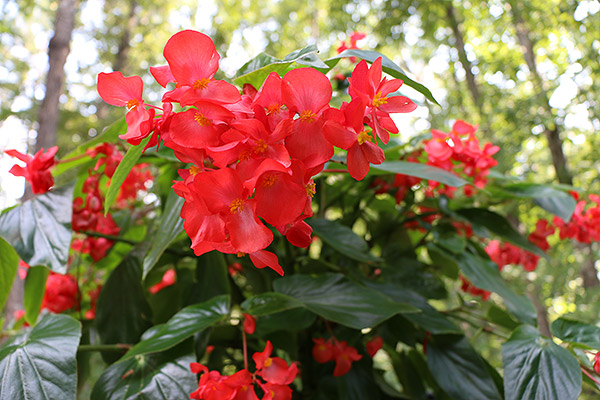 |
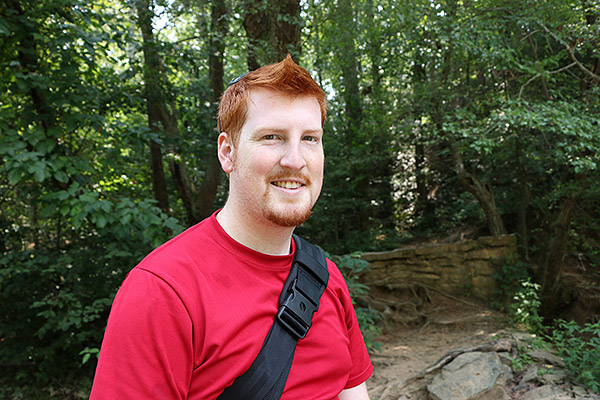 |
The Canon 70D was able to produce nice, bright colors at default Picture Style settings. The notorious "Canon reds" dominate these shots, and are perhaps a little too saturated. |
Video. Now, still photography is only half the story with the 70D. Where the new Dual Pixel CMOS AF technology really shines is with video. Canon appears to be taking aim at the other big shots in the HD video-capable stills camera market, like the Panasonic GH3, for example.
As I said before, Canon was one of the first players to the DSLR video market with the 5D Mark II, but it lacked one crucial feature that average consumers -- accustomed to years of camcorders -- expected from video recording devices: full-time continuous autofocus. Since then, Canon has included full-time autofocus in a number of their DSLRs, but the 70D is the first one that I've seen that really brings "camcorder-like" video autofocusing to the playing field.
Find out why we think the Canon 70D provides the best video autofocusing we've ever seen in a DSLR by watching our Canon 70D Dual Pixel CMOS AF comparison test and sample videos .
I loved shooting video with the 70D, and this comes from a videographer who's stuck by his 5D Mark II and 7D that only have manual focus. Video autofocusing feels smooth and accurate on the 70D. It's not too fast, nor does it hunt back and forth when acquiring focus like you see with contrast-detect AF systems.
The 70D also did an excellent job with video subject tracking. It quickly locked onto most targets and tracked them as they moved, keeping them in sharp focus almost all the time. I especially enjoyed the LCD monitor's touch-to-focus feature for quick-and-easy rack focusing between near and far subjects. Overall, the camera operated very smoothly and didn't quickly jump to refocus like some other cameras do. Again, the 70D's video AF performs very much like that of a camcorder -- and that's saying a ton.
One very cool feature that I realized while shooting video with the 70D is that I no longer need to worry myself much when using lenses that are not parfocal -- lenses that stay in focus when zooming. The vast majority of DSLR lenses are not parfocal, including my go-to choice when shooting DSLR video: the Canon 24-105mm f/4 L IS lens. I would constantly have to readjust the focus ring when I zoomed in or out. The smooth continuous focus of the 70D eliminates that worry, as the camera constantly adjusts focus while you zoom in and out. I experimented with this using both the 18-135mm kit lens and 24-105mm lens, and both worked great and stayed in focus while I racked near and far.
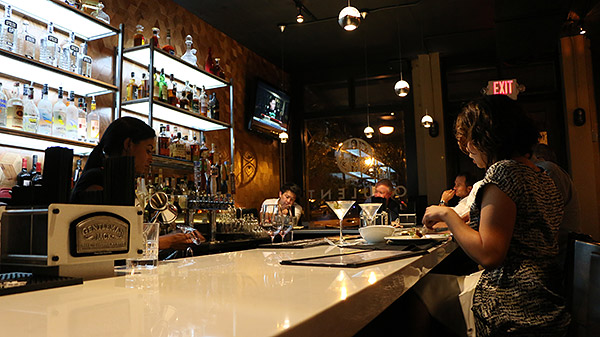 |
You can take still photos in movie mode, although they will shoot in the 16:9 aspect ratio like HD video footage. |
The 70D also beefs up its video recording formats to match Canon's more high-end DSLRs like the 5D Mark III. It features the same 1080/30p/24p and 720/60p resolutions and frame rates as the 60D, but includes ALL-I and IPB compression schemes like the higher-end models. This easily makes the 70D a contender for video enthusiasts and independent filmmakers looking for higher image quality at a reasonably affordable price.
There's a big caveat I need to mention regarding video on the 70D. Despite a stellar experience with Wi-Fi control with still photography, I thought I could do the same with video. Sadly, that's out of the question. In fact, you can't even record video while the Wi-Fi radio is enabled; it doesn't even matter if you don't plan on using the EOS Remote App. If you just leave Wi-Fi enabled -- by accident, for instance -- the camera won't let you record video. A big warning will be displayed on the screen telling you to turn off Wi-Fi.
This is not a deal breaker for me personally, but it's kind of a bummer that remote video recording is out of the question. I later found out that a similar limitation exists with the Canon 6D. I can perhaps see there being technical issues with transmitting the data necessary to stream a Live View picture from the camera to your smart device while simultaneously recording video, but why does simply having Wi-Fi enabled completely disable video recording? If there's not some technical hardware limitation at the root of this, perhaps a future firmware update can offer a remedy.
So what's our final verdict on the Canon 70D? See our full Canon 70D review online, where you'll find a detailed breakdown of its performance and operation, image quality and video autofocusing comparisons against other cameras, more gallery images, a complete list of pros and cons, and our ultimate conclusion: http://www.imaging-resource.com/PRODS/canon-70d/canon-70dA.HTM
-----------------------------------------------------------------------------------------------------
FEATURE: Understanding Bokeh: The Art and Science Behind the Beauty of Blur (Part 1)
-------------
by Paul Harcourt Davies
The term bokeh gets bandied about with some degree of abandon these days, as fashionable or trendy words tend to be. And it's not just popular among the Instagram hipsters. Serious photographers and beginner shooters alike seem to be bonkers for bokeh.
A few of you might have heard the term but may still not know exactly what bokeh is. Bokeh is derived from a Japanese word meaning "blurred" or "hazy," and it's used to describe the character of the out-of-focus areas of a photographic image. There is good and bad bokeh, and judging what's aesthetically pleasing and what's not is entirely subjective.
The overall perception of the character of image blur is, literally, in the eye of the beholder. We all have different tastes. Thus, we have to rely on value judgments to describe it with such adjectives as smooth and creamy or, conversely, hard-edged and harsh. There are no objective measures for bokeh -- nobody has created a "Bokeh-o-meter" -- as far as I know.
In this image of a Swallowtail butterfly hanging to let its wings dry after emergence,
the background is a gentle blur. I'd call this good bokeh.
Photo by Paul Harcourt Davies
Bokeh plays an important compositional role that makes us consider the parts of an image that are not in focus and are separated from the main subject. These blurred areas have often been dismissed as "just the background" by those who don't know any better. However, experienced photographers realize the background has a significant psychological impact in setting the mood of a shot and, in a practical sense, can enhance the apparent sharpness of the subject, or otherwise accentuate it through contrast in color and texture.
As far as I can determine, bokeh first appeared as a term relating to Western photography in recent history when Mike Johnston introduced it in an 1977 issue of Photo Techniques magazine. Much has been written since then, including guides to the term's correct pronunciation -- and explanatory YouTube videos -- revealing how you, too, can be a photo nerd and leap to correct your (ex) friends.
I'll put my photo nerd hat on and hopefully not offend you: The term is not pronounced boke (as in poke), or even bo-kay (as in Bouquet). There are two syllables pronounced without noticeable pause between them: the bo (as in bone or boat) and a short ke (as in kettle or kelp) assuming that your pronunciation of these is standard. But then English (the U.K. or American version) is a capricious tongue and someone is sure to correct you no matter how you say it. (My friend and fellow IR contributor Steve Meltzer sent me this, which seems appropriate: http://www.livescience.com/33652-americans-brits-accents.html.)
Looking closer at bokeh
Bokeh is most strongly in evidence with large aperture lenses of all sorts where the depth of field will inevitably be shallow and large areas may be out of focus. Longer focal length lenses -- telephotos and macro lenses -- accentuate the blur for artistic effect when used at their widest apertures or closed down to about f/5.6 or f/8. Any more, and background detail can be resolved in a distracting way. Medium telephotos used for portraiture work similarly. In fact, bokeh becomes a consideration anywhere where shallow depth of field eliminates background clutter and emphasizes the sharpness of the subject.
Photos by Paul Harcourt Davies
The soft background blurs in the image above (top) made with a 150mm f/2.8 lens contrast strongly with the sharp detail in the 10mm f/2.8 diagonal fisheye (bottom). The mood is completely different, and the wide-angle conveys more information about the surroundings. It is not a question of which is best -- it comes down to what you want to show.
Bokeh tends to be less noticeable with wide lenses unless you are shooting close to a subject at maximum aperture. Typically, a wide-angle lens will render a foreground subject sharp, as well as retaining detail in the background. Meanwhile, telephoto lenses tend to isolate subjects from the background, and it is in that background that bokeh becomes important.
Lenses treat spatial separation of elements in a picture differently according to their focal length -- a good exercise is to photograph a subject with a wide-angle lens and a telephoto and move so that it occupies the same proportion of the viewfinder. With wide-angle lenses you are much closer to a subject than with a telephoto. It all comes down to perspective and the consequence of reducing three dimensions in the real world to the two-dimensional image on a print or screen.
The basis of good bokeh
So, what constitutes "good bokeh"? Well, I'd say a background where highlight blurs have soft edges and demonstrate no sharp distinctions between out-of-focus elements. That basic aesthetic will likely pass the test, though aficionados might well develop finer definitions and, naturally, a specific vocabulary to go with it. And again, I must stress that bokeh is a highly subjective measure. What might look like good bokeh to you and me, might very well not look good to others.
The sharply focused parts of any image can be thought of as points or collections of points, but away from these -- the out-of-focus areas -- the light spreads slightly and those points become tiny circles. These are the so-called blur circles and, we are told, that as long as these circles are no larger than 1/30mm (originally on a 35mm film), then the average human eye cannot distinguish them from a point. This measure was chosen as the diameter of the so-called "circle of least confusion" with 35mm format film work. It is not just a figure plucked from the air, for it has a firmer basis in optics and the way we view prints -- as I shall explain later.
The iris diaphragm and bokeh
We can think of these blurred area as over-lapping circular pools of light where rays have spread out rather than been focused. They are actually diffraction patterns whose edges assume the shape of the lens aperture in the diaphragm through which they pass. If the aperture is a perfect circle, then overlapping images blend beautifully and backgrounds look smooth -- that's good bokeh.
Blur circles with diffraction rings around them.
Photo by Paul Harcourt Davies
In the photo above, distant highlights are caused by reflection from a water surface where the dragonfly perches on a stem. At first I found them disconcerting, but then decided I liked them because they show the faint diffraction patterns at their edges, and because the diaphragm is not perfectly circular. The figure is a 9-sided polygon with curved edges -- and reflects the 9-bladed iris diaphragm that created it.
If the diaphragm aperture is not circular, then the angular edges do not produce perfect circles and the bokeh appears slightly harsh, because the overlap is not smoothly accomplished. The greater the number of diaphragm blades, the more perfectly circular the aperture becomes and -- if these blades are slightly curved -- the better the approximation to a circle. In fact, lens specifications nowadays state the number of blades in the diaphragm as a selling point. Typically, seven or nine blades are considered a good start for producing creamy bokeh.
By the way, the individual diffraction patterns never have sharp contours. If you examine them closely with a microscope, the points have a series of rings and at the edges are lines getting fainter at a very small distance from the main portion of the pattern. This is the reason images break up as we enlarge them and no more detail is revealed -- it is called empty magnification. We just make those pattern edges more obvious.
These flowers -- Alpine snowbells and anemone -- were isolated with a 150mm f/2.8 Sigma macro lens at f/5.6 with no particular thought to bokeh. The background was over a meter away and, with this setting and such a distance, you always create a soft blur. I prefer to concentrate on the subject, and this makes it easy to deal with background softness and subject sharpness.
Photo by Paul Harcourt Davies
Bokeh and depth of field
The diagram below shows how a greater depth of field results from smaller apertures. You can move further either side of the sharpest focus and still get what looks like a point. To emphasize bokeh, we need minimal depth of field from wide-open lenses, preferably those of longer focal length.
By increasing the depth of field, blurred elements in a background begin to obtain form and become identifiable. This can be distracting, but again, it is a question of degrees. That slightly soft focus in wide-angle macro photography allows background elements to be obvious but not intrusive, at the same time emphasizing foreground sharpness.
This image demonstrates the impact of depth of field and perception of bokeh. Heads of wild carrot growing on my land provided a useful comparison with a 300mm f/4 objective. When used wide open (left) the background is soft, easy on the eye, and uniform. When closed to f/22 you see the head is in better focus front to back since the DOF has increased, but also that more is defined in the background in a confusing way. I don't like the term "bad bokeh," but some might see it as such.
Photo by Paul Harcourt Davies
It is not just the circularity of the lens iris (the diaphragm aperture) that affects bokeh; lens aberrations have a role to play, too. The most important is spherical aberration, a defect that that arises when light rays from the edge of a lens and those from its center are not focused at the same point. It is also affected by internal reflections from lens surfaces -- especially common with older lenses created before the days of lens multicoating started to reduce them.
Spherical aberration determines whether the tiny image disks of the diffraction patterns are uniformly illuminated or not, and thus affects bokeh. Disk brightness can vary from edge to center depending on how effectively the spherical aberration is controlled. Discs can be brighter at center than edge (and vice-versa), and there is also a difference in appearance of these discs behind -- and in front of -- the plane of focus.
Catadioptric and other lenses that produce a special bokeh
An unmistakable bokeh effect occurs with mirror telephoto lenses, also known as catadioptric lenses. These lenses cause out-of-focus highlights to become "donuts." The center of each light disc is blocked out because it is imaging the main mirror in the lens that is, in turn, partially blocked by a secondary mirror inside the lens.
Some like this donut bokeh, and some do not. If you like the donut effect, then you should consider experimenting with a catadioptric lens.
Some other lenses have been designed with the capacity for changing the way the out-of-focus areas appear by increasing the degree of spherical aberration, and there are add-ons to cameras within the LensBaby series, for example, that do the same.
This image of wild orchids was taken with a Meyer Trioplan triplet lens by talented Italian photographer Leonardo Battista. He has a mastery of this lens, for his flower portraits capture an ethereal feel. Getting a photo like this does not happen quickly; I have worked with him, and his patience and determination to get what he wants takes considerable time and effort. Leo is no point-and shoot-photographer!
Photo �Leonardo Battista
In recent years, a particular vintage lens has become a great favorite with nature photographers intent on creativity, and eBay prices have rocketed as a result. The lens is a simple design, a Cooke Triplet that has three strong lens elements separated by comparatively large air spaces. Originally made for Exakta, this is the Meyer-Optik Gorlitz Triplan 1:2.8 100mm lens which many have re-mounted for Canon, Nikon and other systems.
The construction imparts some unique characteristics to out-of focus highlights, giving them an ethereal, soap-bubble look which creates a halo of sorts around light objects. It is extremely effective, but very easy to over-use. In the artistic right hands of proponents such as Sandra Bartocha and Leonard Battista, it can be an amazing creative tool.
If you like to experiment and have a cheap extension tube on hand -- you can easily find an inexpensive one on eBay -- then try an old lens from a slide projector. These lenses have just a few internal elements, all air-spaced, with no internal diaphragm, and can produce very interesting bokeh. Point it at a scene with distinct highlights and you may be surprised at the results!
Paul Harcourt Davies is a long-time professional photographer, and an author of 19 books with a background that fuses technical and artistic elements to his life-long passion for photography of the natural world. We reviewed his e-book (that he co-wrote with frequent collaborator Clay Bolt): Wide-Angle Macro: The Essential Guide a few months ago, and we knew we wanted to share more of his insights and amazing images with our readers. (You can order a copy of the book here.) An experimenter and innovator by
nature, he has long been on a mission through his writing and lectures to bring the techniques of macro photography to others. For the last 10 years he has been based in Umbria, central Italy, renovating an old farmhouse with a wild garden from where he organizes tours, workshops and much else.
Be sure to read Understanding Bokeh, Part 2: The Fine Line Between Sharpness and Blur.
-----------------------------------------------------------------------------------------------------
QUICK HITS: The most interesting, most read articles on the IR site in the past two weeks
----------------
Olympus E-M1 review: First impressions and samples from the new OM-D flagship camera
By Mike Tomkins
With the announcement last week of the Olympus E-M1�(see sample photos here!), two birds have been killed with one stone. The E-M1 is both a new flagship for the OM-D series, and a replacement for the long-in-the-tooth Olympus E-5 digital SLR. In one smooth move, Olympus has given the OM-D series a new aspirational benchmark, and answered the concerns of photographers shooting with its Four Thirds-series SLRs, who've long wanted to know the future of their seemingly-dormant format. And it's answered in style, delivering a camera that combines the best of both the SLR and mirrorless worlds, and adds some significant, brand-new features, as well.
And that's not all. Alongside its new enthusiast (and arguably, professional)-friendly mirrorless body, Olympus has also announced a brand-new high performance Micro Four Thirds lens series, and a raft of accessories related to the E-M1 body. We'll come back to those in a moment, but first, the camera itself.
The 16-megapixel E-M1 is the first Olympus mirrorless camera with on-chip phase detection autofocus, resolving performance issues when shooting with Four Thirds lenses. It has a mighty-impressive electronic viewfinder which is, in essence, a refined version of the well-received VF-4 viewfinder accessory. It also boasts a higher-resolution tilting monitor, and adds freezeproofing to its roster of outdoors-friendly shooting features. And acknowledging that sharing is key, it sports in-camera Wi-Fi connectivity, although this too has been refined since we first saw it in the PEN E-P5 compact system camera.�And there's plenty more, besides.
Learn more by reading our hands-on, first impressions Olympus OM-D E-M1 review!
-----------------------------------------------------------------------------------------------------
How I split from the herd while photographing the 'Days of the Bulls' festival in Tourbes, France
By Steve Meltzer
During the first weekend of September, while friends and family back in America were having Labor Day picnics, in my village of Tourbes, France, we were literally playing with bulls. Please note that I said play. Though in Mediterranean Europe there is a strong bullfighting tradition, at the Journ�es Taurines -- our "Days of the Bulls" festival -- we don't fight bulls in any sense of the word. Man and beast play together, and no one is injured.
There are lots of events during the three days of the Journ�es Taurines, the highlight of which is the chasing of young bulls. The bulls, hemmed in and controlled between riders on powerful white horses, are madly chased down a long, tree-lined avenue by young men from around the area. To prove their manhood, the men attempt to catch up with the bulls and grab their tails. Few actually succeed, but the fun is in the chase and the crowds cheering them on. The manhood element is diluted by the fact that hundreds of the spectators -- tourists, children, women and the elderly who are supposed to stay behind protective barriers -- loiter about in the street in the path of the oncoming bulls and horses. It's all in the name of fun; there's nothing to fear.
To see all of Steve's photos, and read how he "left the crowd" and searched for an entirely different way to cover the 'Days of the Bulls' celebration, check out the full story here.
-----------------------------------------------------------------------------------------------------
Sony NEX-3N review: Camera for beginners delivers a smooth step-up from point-and-shoots -- and a terrific bang for your buck
By Roger Slavens
In developing a replacement to last year's successful NEX-F3, Sony aimed to deliver nothing less than the world's smallest and lightest interchangeable lens system that featured an APS-C-sized sensor. Mission accomplished with the entry-level Sony NEX-3N, which pares down both the size and price from its predecessor -- albeit with a few sacrifices along the way. The end result is a camera that may present the most seamless step-up from a point-and-shoot experience that we've ever seen.
And it's not just the compact form and value of the camera. The Sony NEX-3N's user interface is simple and straightforward, forgoing physical controls -- such as a Mode dial -- for a menu-based system that digicam users will be comfortable with. There's even a zoom lever control on the camera itself, much like you'd find on a typical pocket model. Photographers can leave the NEX-3N in full auto mode, or dive into the menus to learn more about advanced modes and settings.
Read our in-depth Sony NEX-3N review for full details and our final verdict!
-----------------------------------------------------------------------------------------------------
WE'VE GOT MAIL: Questions from readers, answers from IR
-----------------------
Please send us your camera and photography questions and comments (editor@imaging-resource.com). Not only will we respond to each and every one of your letters, but we'll also publish the best ones here as a resource for all our readers.
Need a file renaming utility to help me process two camera's worth of photos
Dave --
After years with a Canon 5D Mark I, I have now bought a 6D as well. Apart from catching up on noise reduction advances and better low-light focusing, I wanted the opportunity to have two cameras with 17-40mm and 70-200mm glass for action-packed events.
My problem, which must be common to others operating two cameras, is organizing the images in the sequence I want afterwards to show them as a slideshow from a DVD or USB. Moving and renaming them in the Windows picture-managing system seems to work at first, but in Canon's applications Zoombrowser / Imagebrowser they resume their previous positions, seemingly locked by the file information. Is there a way to get around this?
Yours sincerely,
Peter Salicath, Denmark
---------------------
Hi Peter --
What you might try would be to first, make sure that the clock settings in the cameras are in sync with each other, then use some sort of a file-naming utility to add a date/timestamp to the front of the filenames.
On the Mac, there's an excellent (commercial, not free) utility called A Better Finder Rename, that would do the trick nicely. I'm not sure what app would work on Windows. There's Bulk Rename Utility, but that only seems to be able to append date and time information, which wouldn't help with the sorting. Advanced Renamer is very powerful, and seems as though it could do the job, but it has a pretty opaque, computer-geeky user interface. Finally, Rename Master seems to be a similar free utility, also with a geeky user interface.
Beyond these, I'm not sure what to suggest on the Windows platform. How about it, readers? Do you have a favorite file-renaming utility that might help Peter out?
-- Dave
-----------------------------------------------------------------------------------------------------
Re: Why People Don't Like Their Portraits Taken
Dave --
When I started professionally some 40-plus years ago, it was common knowledge why people did not like their portraits taken. I had to explain that a mirror image is not the way other people saw you! That is why the pentaprism was invented for SLR cameras as photographers did not have to deal with a reversed image as they did in the old view cameras.
Regards,
Allan Porter, New Zealand
---------------------
Hi Allan --
Interesting! That's one of those things that's apparently been lost along the way. The image in old view cameras was also upside-down, which I'd imagine was a bigger problem than left-right reversal. Still, very interesting, thanks for sharing!
-- Dave
-----------------------------------------------------------------------------------------------------
Wasn't the Sony R1 the first mirrorless camera?
To Mike Tomkins --
I enjoyed reading your Sony A3000 first impression review. I am a big Sony fan. However I feel you erred in stating the Sony NEX line was the first mirrorless camera. I love my Sony R1, which was their first mirrorless camera I believe.
Thanks for your articles!
Sam Ruljancich
---------------------
Hi Sam --
The R1 was indeed an excellent, even landmark camera, but it didn't have an interchangeable lens, which is what people are generally talking about when they say "mirrorless camera." (If we remove the interchangeable-lens criteria, then every pocket digicam would technically fall into the mirrorless category.)
-- Mike
-----------------------------------------------------------------------------------------------------
Smartphone camera reviews, please!
Hi guys at IR --
If you guys would recall, I earlier asked for a Nokia 1020 review. Ideally, I want to see comparison samples from the Samsung Galaxy Zoom, Nokia 1020 and the brand new Sony Xperia Z1. So if ever you got your hands on them, I wish you could review them! :)
Thanks in advance and more power to your site! :D
�
Razec21
---------------------
Hi Razec --
Thanks for this second vote for a smartphone camera test or shootout. It's definitely something we'd like to get to, but we're so bogged with the dozens of new and significant conventional cameras that have been released this year that it's hard to say when we might get to it. We're pretty much in peak "crunch mode" at the moment, and things aren't likely to slack off any until January.
Who knows, though, maybe we can grab a few lab shots, assign it to one of our writers, and do something quick and easy that'd still be helpful in making a decision based on image quality considerations.
Thanks again for the input!
-- Dave
-----------------------------------------------------------------------------------------------------
NEW ON THE SITE
-----------------------
At http://www.imaging-resource.com/new-on-ir you can keep track of what's new on our main site. Among the highlights since the last issue:
- Camera Preview: Nikon AW1 is the world's first waterproof, shockproof mirrorless camera that wants to be like a digital Nikonos Lite (http://www.imaging-resource.com/news/2013/09/19/nikon-aw1-preview-waterproof-shockproof-mirrorless-camera-digital-nikonos)
- Cool Tech: Check out the incredible hidden cameras the East German Stasi used to spy on people (http://www.imaging-resource.com/news/2013/09/19/a-look-at-the-incredible-hidden-cameras-of-the-stasi)
- Awkward Video: Minister stops wedding ceremony to yell at photographer (http://www.imaging-resource.com/news/2013/09/19/minister-stops-wedding-ceremony-to-yell-at-photographer-awkward-video)
- Lens Review: Sigma 1.4x teleconverter offers hefty savings at the expense of image quality (http://www.imaging-resource.com/news/2013/09/18/sigma-1.4x-teleconverter-review)
- Stunning Image: Aerial photo shows torrential rainfall over Colorado (http://www.imaging-resource.com/news/2013/09/18/stunning-aerial-photo-purportedly-shows-torrential-rainfall-over-colorado)
- Awesome Video: Feel what it's like to fly like an eagle with this soaring bird's-eye POV video
(http://www.imaging-resource.com/news/2013/09/18/feel-what-its-like-to-fly-like-an-eagle-with-this-soaring-birds-eye-video)
- Camera Preview: Fujifilm makes X-mount mirrorless even more affordable with the Fuji X-A1
(http://www.imaging-resource.com/news/2013/09/17/fujifilm-x-mount-mirrorless-more-affordable-with-the-entry-level-fuji-x-a1)
- Photography Documentaries: The best photography documentaries to watch online for free (http://www.imaging-resource.com/news/2013/09/13/the-best-photography-documentaries-to-watch-online-for-free)
- Smartphone Camera Preview: Apple unveils iPhone 5s with major camera upgrades (http://www.imaging-resource.com/news/2013/09/10/apple-unveils-iphone-5s-major-camera-upgrade-bigger-pixels-dual-flash-fast)
-----------------------------------------------------------------------------------------------------
NEXT ISSUE
---------------
Our next issue will be mailed to you in two weeks on Friday, October 4. See you then!
SIGNOFF
-----------
That's it for now, but between issues visit our site for the latest news, reviews, or to have your questions answered in our free discussion forum. Here are the links to our most popular pages:
Newsletter Archive: http://www.imaging-resource.com/cgi-bin/dada-nltr/mail.cgi/archive/irnews
Daily News: http://www.imaging-resource.com/news
SLR Gear: http://www.slrgear.com
New on Site: http://www.imaging-resource.com/new-on-ir
Review Index: http://www.imaging-resource.com/camera-reviews
IR Photo Contest: http://www.dailydigitalphoto.com
Google + http://plus.google.com/+imagingresource
Facebook: http://www.facebook.com/imagingresource
Twitter: http://www.twitter.com/IR_Lab
Happy snapping!
Dave Etchells and Roger Slavens
editor@imaging-resource.com
|




